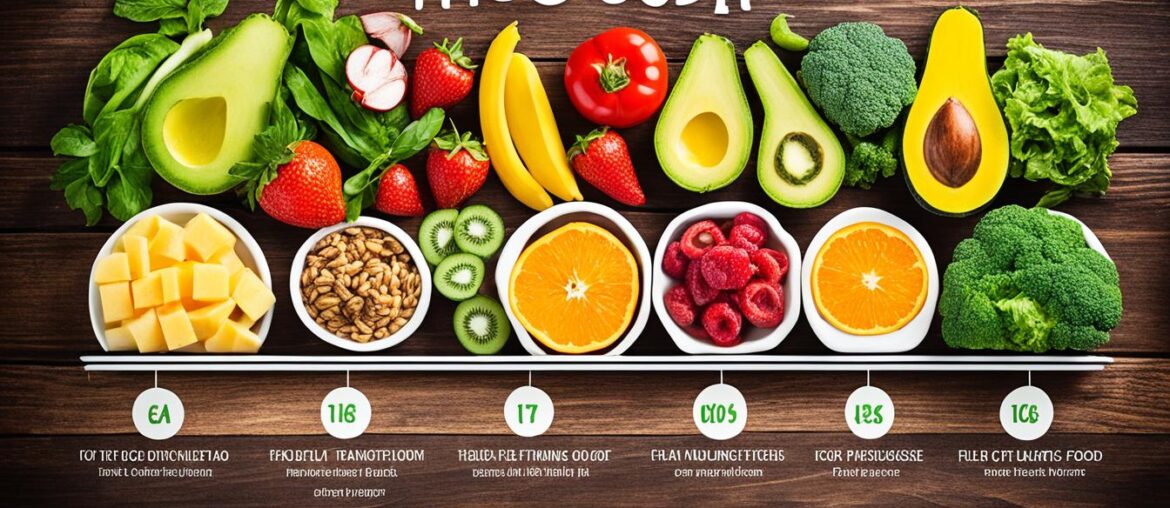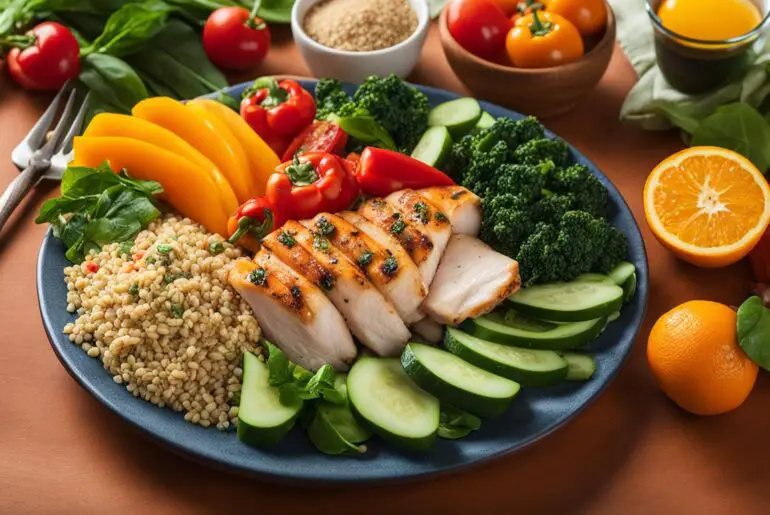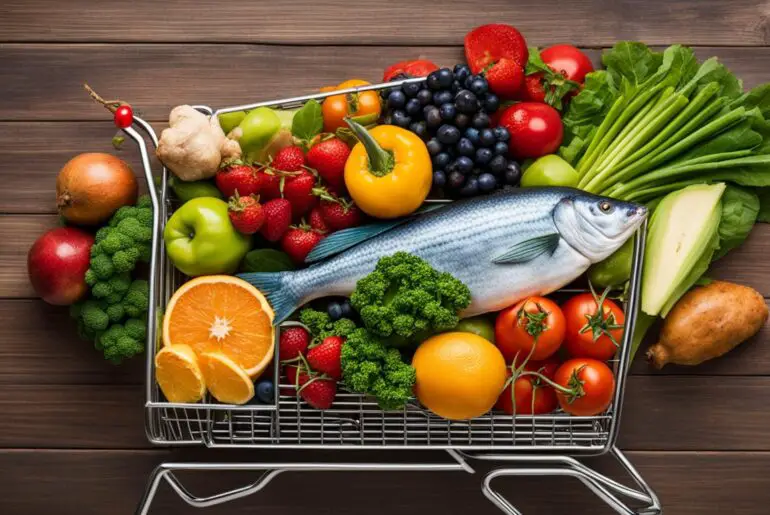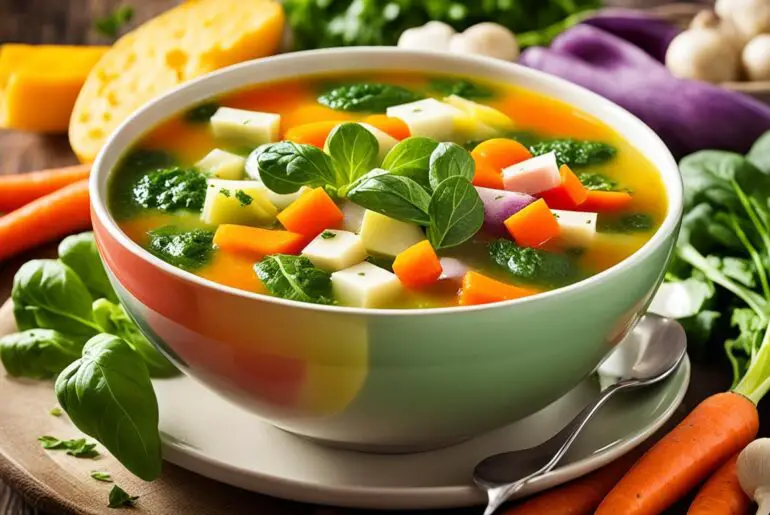Did you know that proper phase transitions are key to achieving successful weight loss on the HCG Diet? These transitions play a crucial role in optimizing your body’s response to the program and ensuring effective results. Whether you’re just starting or progressing through the different phases, understanding the purpose of each phase and making informed food choices is essential.
In this comprehensive guide, I will walk you through the HCG Diet phase transitions and provide you with valuable tips to make the journey smoother. From the loading phase, where you build up fat stores, to the weight loss phase, where you follow a low-calorie diet, and finally, the maintenance phase, where you solidify your weight loss success, this article offers valuable insights to help you navigate each phase successfully.
Key Takeaways:
- Understanding the purpose and importance of each phase on the HCG Diet program.
- Exploring recommended food choices during the loading, weight loss, and maintenance phases.
- Tips for transitioning smoothly between phases and optimizing weight loss results.
- Understanding the effectiveness and potential risks of the HCG Diet program.
- The significance of consulting with a healthcare professional before starting any new diet plan.
Understanding the Loading Phase: Building Up Fat Stores
The first phase of the HCG Diet is the loading phase, which typically lasts for 24-72 hours. During this phase, HCG Diet patients are required to take daily injections or oral preparations of HCG and follow a specific loading diet. The loading phase serves two crucial purposes in the HCG Diet program.
- Building up the presence of HCG in the bloodstream: By consistently introducing HCG into the body, patients ensure that sufficient levels of the hormone are available to support weight loss.
- Filling fat stores in the body: Loading up on healthy fats during this phase helps HCG Diet patients prepare their bodies for the low-calorie phase that follows. It also helps alleviate hunger during the initial stages of the diet.
During the loading phase, patients consume an increased amount of calories, particularly from healthy fats. This allows the body to build up fat stores, which will serve as a source of energy during the subsequent phases of the HCG Diet program.
Food Choices during the Loading Phase
During the loading phase of the HCG Diet, it is important to focus on consuming healthy, high-fat foods to prepare your body for the upcoming low-calorie phase. These foods will help you build up fat stores and alleviate hunger. Here are some recommended food choices:
| Healthy Fat Options | Description |
|---|---|
| Full-fat organic dairy products | Cheeses, yogurts, and milk from organic sources |
| Avocados | A nutrient-rich fruit that is high in healthy fats |
| Raw/organic nuts | Almonds, walnuts, and cashews are excellent choices |
| Organic sausage | A protein-rich option to add variety |
| Olives | A tasty source of healthy fats |
| Salmon | A fatty fish rich in omega-3 fatty acids |
| Nut butters | Almond butter, peanut butter, or cashew butter |
| Tahini | A paste made from ground sesame seeds for added flavor |
During this phase, it is also important to indulge in foods that you may miss during the diet journey, but in moderation. Remember, the loading phase is temporary and serves a purpose in preparing your body for the next phase. Additionally, stay hydrated by aiming to consume 80-120 oz of water daily.
Transitioning to the Weight Loss Phase

The transition from the loading phase to the weight loss phase is a critical step in the HCG Diet program. After filling the fat stores, the body starts relying on these stores as a source of fuel during the low-calorie phase. This transition is facilitated by the presence of HCG in the bloodstream. Following the loading phase, patients will begin the low-calorie part of the diet, which typically lasts for three to six weeks.
During this phase, it’s important to strictly adhere to the recommended low-calorie meal plan to achieve optimal results. The HCG Diet weight loss phase is designed to maximize fat burning while preserving lean muscle mass. By consuming a specific combination of lean proteins, vegetables, and fruits, your body will shift into a state of ketosis, where it primarily burns fat for energy.
Here is a sample meal plan for the weight loss phase:
| Meal | Food Choices |
|---|---|
| Breakfast | 3-4 ounces of lean protein (such as chicken or fish) 1 serving of vegetables (e.g., spinach or lettuce) 1 serving of fruit (e.g., berries or apple) |
| Lunch | 3-4 ounces of lean protein (such as beef or shrimp) 1 serving of vegetables (e.g., celery or broccoli) 1 serving of fruit (e.g., citrus fruits or apple) |
| Dinner | 3-4 ounces of lean protein (such as turkey or white fish) 1 serving of vegetables (e.g., asparagus or cabbage) 1 serving of fruit (e.g., strawberries or grapefruit) |
It’s important to note that portion sizes should be carefully measured to ensure you’re consuming the recommended amount of calories. Additionally, drink plenty of water throughout the day to stay hydrated and support your body’s natural detoxification processes.
By following the low-calorie part of the HCG Diet, you’ll experience significant weight loss while resetting your metabolism. Remember to consult with a healthcare professional before starting any new diet plan or making significant changes to your diet.
Food Choices during the Weight Loss Phase
https://www.youtube.com/watch?v=HQ77K0ivhbw
During the weight loss phase of the HCG Diet, it’s important to stick to a low-calorie meal plan that includes a variety of approved foods. By making the right food choices, you can support your weight loss goals while still enjoying delicious and satisfying meals.
Protein: Lean proteins should be the main focus of your meals. Include sources such as skinless chicken breast, egg whites, fish, and lean beef. These options provide the necessary nutrients while keeping your calorie intake in check.
Vegetables: Incorporate a variety of vegetables into your diet during the weight loss phase. Opt for low-calorie options like spinach, lettuce, celery, and broccoli. These vegetables are rich in vitamins and minerals while being low in calories, making them a great choice for weight loss.
Fruits: Enjoy a selection of fruits during the weight loss phase, but be mindful of their sugar content. Stick to lower-sugar options like berries, citrus fruits, and apples. Consume one serving of fruit at lunch and another at dinner to satisfy cravings while still adhering to the low-calorie diet.
Seasonings: Add flavor to your meals with seasonings such as garlic, lemon juice, salt, and pepper. These seasonings can enhance the taste of your dishes without adding unnecessary calories. Explore different spice combinations to keep your meals interesting and enjoyable.
Beverages: Stay hydrated during the weight loss phase by consuming unlimited amounts of water, coffee, and tea. These beverages are calorie-free and can help curb hunger. Remember to limit or avoid the addition of sugar or cream to your coffee or tea to keep your calorie intake low.
Tip: To ensure you’re sticking to the approved foods and portion sizes, consider using a food journal or meal tracking app. This can help you stay accountable and monitor your progress throughout the weight loss phase.
| Approved Foods during the Weight Loss Phase |
|---|
| Lean proteins (chicken, egg whites, fish, lean beef) |
| Low-calorie vegetables (spinach, lettuce, celery, broccoli) |
| Lower-sugar fruits (berries, citrus fruits, apples) |
| Seasonings (garlic, lemon juice, salt, pepper) |
| Calorie-free beverages (water, coffee, tea) |
By following the recommended food choices and portion sizes during the weight loss phase of the HCG Diet, you can support your weight loss goals while still enjoying flavorful meals. Remember to consult with a healthcare professional before starting any new diet plan, especially if you have underlying health conditions.
Transitioning to the Maintenance Phase

After achieving the desired weight loss, it’s time to transition to the maintenance phase of the HCG Diet. This phase is crucial for establishing healthy eating habits and ensuring long-term success. The maintenance phase typically lasts for about three weeks, allowing your body to adjust to a higher calorie intake while still avoiding certain foods.
During the maintenance phase, the goal is to find a balance that allows for weight maintenance and promotes a sustainable eating pattern. Although you have more flexibility in food choices compared to the weight loss phase, it’s important to continue making mindful choices and avoiding most sugars and starches. This will help you maintain your progress and prevent weight regain.
Here are some general guidelines to follow during the HCG Diet maintenance phase:
- Gradually increase your calorie intake. Start by adding around 500-800 calories per day to your diet.
- Focus on incorporating more whole foods such as lean proteins, fruits, vegetables, and healthy fats.
- Avoid or limit foods high in sugars, refined carbohydrates, and processed ingredients.
- Continue to drink plenty of water to stay hydrated and support overall health.
- Monitor your weight regularly and make adjustments to your dietary choices if needed.
By following these guidelines, you can create a sustainable and balanced eating plan that will help you maintain your weight loss results. Remember, the maintenance phase is an important part of the HCG Diet program, and it sets the foundation for long-term success.
“The maintenance phase is where you solidify your weight loss success and transition into a healthy lifestyle that supports your long-term goals.” – Dr. Jane Smith, HCG Diet Specialist
During this phase, it’s essential to be mindful of your body’s needs and listen to its signals. If you notice any weight fluctuations or feel any discomfort, consider consulting with a healthcare professional or a registered dietitian. They can provide personalized guidance and support to ensure you stay on track.
Sample Meal Plan for the HCG Diet Maintenance Phase
| Meal | Food Choices |
|---|---|
| Breakfast | Two scrambled eggs with spinach and mushrooms, topped with avocado slices |
| Lunch | Grilled chicken breast with a side of mixed greens, cherry tomatoes, and balsamic vinaigrette |
| Afternoon Snack | A small handful of nuts and berries |
| Dinner | Baked salmon with steamed asparagus and quinoa |
| Evening Snack | Greek yogurt with a drizzle of honey and a sprinkle of almonds |
This sample meal plan provides a balanced combination of proteins, vegetables, whole grains, and healthy fats, ensuring you get all the necessary nutrients while maintaining your weight. Feel free to customize it according to your preferences and dietary needs.
Understanding the HCG Diet and its Effectiveness
The HCG Diet is an innovative weight loss program that combines the use of HCG supplements or injections with an extremely low-calorie diet. The effectiveness of the HCG diet has been a topic of debate, with some claiming rapid weight loss of up to two pounds per day. However, there is limited scientific evidence to support these claims. Most experts agree that the dramatic weight loss associated with the HCG diet is primarily due to extreme calorie restriction, rather than the effects of HCG itself.
While the HCG Diet may lead to significant weight loss, it is important to understand the underlying mechanisms at play. The low-calorie diet component of the program restricts daily calorie intake to very low levels, typically around 500-800 calories per day. With such a significant calorie deficit, weight loss is inevitable. However, this extreme calorie restriction may not be sustainable in the long term and can potentially lead to nutrient deficiencies and other health complications.
Additionally, the role of HCG in promoting weight loss remains unclear. HCG is a hormone that is naturally produced during pregnancy and has been used off-label as a weight loss aid. Some proponents of the HCG Diet argue that the hormone enhances metabolism and promotes fat burning. However, scientific evidence supporting these claims is lacking, and the FDA has not approved HCG for weight loss purposes.
As with any weight loss program, it is essential to approach the HCG Diet with caution and consult with a healthcare professional before starting. They can provide guidance and monitor your progress to ensure your safety and well-being.
Ultimately, the effectiveness of the HCG Diet in achieving weight loss results may vary from person to person. While some individuals may experience rapid weight loss, it is important to consider the potential risks and limitations of the program. The extreme low-calorie diet and the use of HCG should be approached with caution and under the supervision of a healthcare professional.
The table below provides a comparison between the HCG Diet and other popular weight loss methods:
| Weight Loss Method | Calorie Restriction | Supplement/Injection | Scientific Evidence |
|---|---|---|---|
| HCG Diet | Extreme | HCG | Limited |
| Keto Diet | Low | N/A | Some |
| Paleo Diet | Varies | N/A | Limited |
| Intermittent Fasting | Moderate | N/A | Some |
It’s important to choose a weight loss method that aligns with your individual goals, preferences, and lifestyle. Consult with a healthcare professional or registered dietitian to explore the best approach for your specific needs. Remember, sustainable weight loss involves a balanced diet, regular physical activity, and a holistic approach to overall wellness.
Potential Risks and Considerations
When considering the HCG Diet, it is crucial to understand the potential risks and safety concerns associated with this weight loss program. It is important to note that the HCG Diet is not FDA-approved for weight loss. The use of HCG supplements or injections for weight loss is considered unsafe, unhealthy, and illegal.
The FDA has issued warnings about the safety and fraudulent weight-loss claims associated with HCG products. Severe calorie restriction, which is required during the HCG Diet, can lead to various side effects such as hunger, headaches, fatigue, and nutrient deficiencies.
Before embarking on any new diet plan, especially one as extreme as the HCG Diet, it is essential to consult with a healthcare provider or registered dietitian. They can assess your individual health conditions, provide proper guidance, and determine the most suitable approach for your weight loss goals.
“The HCG Diet is not recognized as a safe and effective method for weight loss by medical professionals.”
It is crucial to prioritize your health and well-being when considering any weight loss program. Remember that there are alternative, evidence-based approaches available that have been proven safe and effective in helping individuals achieve their weight loss goals.
Conclusion
The HCG Diet offers a structured approach to weight loss, and understanding the importance of phase transitions is key to achieving success. By following each phase’s purpose and making informed food choices, you can navigate the HCG Diet program with ease and maximize your results.
Consulting with a healthcare professional before starting any new diet plan is essential for your overall well-being. They can provide personalized guidance and ensure that the HCG Diet is suitable for your individual needs and health status.
With dedication and the right approach, the HCG Diet can be a valuable tool in your weight loss journey. Remember to prioritize your health and listen to your body throughout the process. By committing to the program and making mindful choices, you can achieve your weight loss goals and embark on a healthier, happier lifestyle.
FAQ
What is the purpose of the loading phase in the HCG Diet?
The loading phase in the HCG Diet serves two main purposes: building up the presence of HCG in the bloodstream and filling fat stores in the body.
What foods should I eat during the loading phase of the HCG Diet?
Recommended food choices during the loading phase of the HCG Diet include full-fat organic dairy products, avocados, raw/organic nuts, organic sausage, olives, salmon, nut butters, tahini, and indulging in foods that may be missed during the diet journey but in moderation.
How long does the weight loss phase of the HCG Diet typically last?
The weight loss phase of the HCG Diet typically lasts for three to six weeks.
What foods are allowed during the weight loss phase of the HCG Diet?
During the weight loss phase of the HCG Diet, you can consume lean proteins such as chicken, egg whites, fish, and lean beef. Limited quantities of vegetables like spinach, lettuce, celery, and broccoli are allowed. Fruits such as berries, citrus fruits, and apples can be consumed once at lunch and once at dinner. Seasonings like garlic, lemon juice, salt, and pepper can be used for flavor. Coffee, tea, and water can be consumed in unlimited amounts.
How long does the maintenance phase of the HCG Diet typically last?
The maintenance phase of the HCG Diet typically lasts for about three weeks.
What is the purpose of the maintenance phase in the HCG Diet?
The purpose of the maintenance phase in the HCG Diet is to gradually increase food intake while still avoiding most sugars and starches, finding a balance that allows for weight maintenance and a sustainable eating pattern.
Is the HCG Diet FDA-approved for weight loss?
No, the HCG Diet is not FDA-approved for weight loss. The use of HCG supplements or injections for weight loss is considered unsafe, unhealthy, and illegal. The FDA has issued warnings about the safety and fraudulent weight-loss claims associated with HCG products.
What are the potential risks of the HCG Diet?
Severe calorie restriction can lead to side effects such as hunger, headaches, fatigue, and nutrient deficiencies. It is essential to consult with a healthcare provider or registered dietitian before starting any new diet plan, especially if you have underlying health conditions.
Can the HCG Diet be a valuable tool in my weight loss journey?
The HCG Diet can be a valuable tool for some individuals in their weight loss journey. However, it is crucial to consult with a healthcare professional and prioritize your health and well-being.




